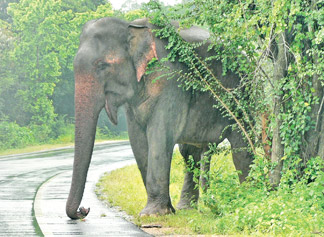|
Pachyderms in focus:
Jumbo operation to count elephants
By Dhaneshi YATAWARA
 After months of careful planning, training and organising, wildlife
authorities are ready to launch the mammoth task of counting and
studying the Sri Lankan elephant population. The islandwide elephant
survey will be conducted from August 11 - 13, 2011 covering 15 national
parks. The ultimate success of this mission would be laying a proper
path for a sustainable elephant conservation to which the survey and
study will be a foundation. After months of careful planning, training and organising, wildlife
authorities are ready to launch the mammoth task of counting and
studying the Sri Lankan elephant population. The islandwide elephant
survey will be conducted from August 11 - 13, 2011 covering 15 national
parks. The ultimate success of this mission would be laying a proper
path for a sustainable elephant conservation to which the survey and
study will be a foundation.
According to the Department of Wildlife Conservation this is a Rs. 20
million worth mission which has received funding from generous private
companies and institutes, both local and international.
Undoubtedly it is the hope of every nature enthusiastic Sri Lankan
that this elephant survey will greatly support to save our elephants at
a time when the entire country is heading towards a rapid development.
This survey would definitely back up the proper implementation of the
National Policy for the Conservation and Management of Wild Elephants
formulated in 2006. Considering past statistics the Department of
Wildlife Conservation (DWC) has spent more than 50 percent of its
working time and allocated budget to mitigate the human-elephant
conflict. In order to bring a sustainable solution to the Human-Elephant
Conflict knowing the numbers (of elephants) is crucial.
 |
 |
| Dr. Chandrawansa Pathiraja |
S.R.B. Dissanayake |
The elephant, Sri Lankan flagship species, belongs to the Asian
elephant category of the global elephant population.
The Asian elephant population is distributed in the Southeast Asia
from India in the west to Borneo in the east.
Three subspecies of these giants are recognised in the region - i.e.
elephas maximus maximus from Sri Lanka, the Indian elephant elephas
maximus indicus from mainland Asia, and elephas maximus sumatranus from
the island of Sumatra.
The Asian elephant is listed in Appendix I of the Convention on
International Trade in Endangered Species of Wild Fauna and Flora
(CITES) which highlights the most endangered among the CITES-listed
animals and plants.
They are threatened with extinction and CITES prohibits international
trade in specimens of these species except when the purpose of the
import is not commercial.
"Asian elephants are cramped in 13 countries in the region
comparatively to the African elephants which lives in 57 countries of
the subcontinent," said DWC's Deputy Director for Research and Training
S.R.B. Dissanayake. Thus undoubtedly knowing the exact number of
elephant population is vital for a harmonised existence of elephants and
humans.
Difficulty
To a non technical person, counting elephants, would seem to be easy
to carry out accurately because of their size. Professor Charles
Santhiapillai - a leading elephant expert involved in the survey - point
out in one of his earlier papers named 'Counting elephants in wild',
that "Unfortunately, it is more difficult to count elephants in a forest
than fish in a pond!
According to Dissanayake 1553 observation points are set up island
wide. "At each point an official from the DWC will be available along
with the assistance from individuals from several Non Governmental
Organizations as well as volunteering environmentalists and villagers
from the respective areas," Dissanayake added. For the survey in the
Northern Province the Sri Lanka Army has extended their helping hand.
Along with the wildlife officials, soldiers of the Army will search the
wilderness of the North that was unexplored nearly for two decades.
Elephants could be mistakenly recounted or would be mis-counted as
the subjective area is large. Surveys are usually conducted using the
sampling method. A smaller area is surveyed, the animals counted, sexed
and classified at specific localities where elephants are likely to come
- for example water holes. Generally, such surveys are conducted during
the peak, the drought period as elephants are expected to visit the few
remaining water holes. With the onset of rain, elephants tend to move in
to other areas where water is abundant, Dissanayake explained. Thus the
ideal period for Sri Lanka would be either August or September. As the
wildlife authorities further explained, counting elephants at a water
hole brings an advantage as it enables to find out the population
structure and composition as well. It will enable the authorities to
determine the proportion of calves relative to the adult females. This
will also help identify the tuskers - the ones that are most vulnerable
in the wild.
"There is a wide variety of survey methods and each method has its
advantages and disadvantages," Dissanayake explained further. The
objectives of the survey are mainly to determine the composition of the
population,to find out the proportion of calves, juveniles, sub-adults
and adults, to determine the proportion of tuskers, the sex ratio and to
the health condition of the animals. Following globally recognised
mechanisms the Wildlife authorities have set up a methodology to class
elephants according to their age. Elephants under three feet in height
are considered as calves. Juvenile elephants would be those between 3
feet and 4.5 feet. Elephants with a height between 4.5 and 6 are
considered as sub adults and adults are 6 feet and more.
Special training programs for the non wildlife officials - i.e.
volunteers, villagers, army personnel - were conducted by the DWC as
well as at their regional level. Pocket meetings were held at village
level to educate the villagers.
Pest to asset
The survey is solely conducted to tackle elephant conservation and
identify problems that crop up with elephants damaging the food crops of
the farmers. "The DWC is the management authority for elephant and other
wildlife in the country. Thus it is necessary for us to know the status
of our elephant population," DWC Director General Dr. Chandrawansa
Pathiraja said. "We need to exactly know whether the population is
increasing, decreasing or remaining stable. We need these inputs in
order to reduce conflict and to relax pressure on habitats," Dr.
Pathiraja further said.
As their densities increase, people become more and more intolerant
of wildlife that threatens their livelihoods. According to the DWC, at
present wild elephants are being killed at the rate of three animals per
week. These animals are not solely killed for tusks and they're not
killed for their meat, they are being slaughtered simply because they
interfere with agriculture and threaten the livelihood of people. To
villagers of an effected areas elephants have become an unwelcome burden
and a dangerous pest. The mindset of people need to be enlightened with
the value of an elephant as an asset to the natural eco-system in which
the humans are at the receiving end. For generations our predecessors
lived with this giant wonder of the mother nature - except may be for
few accidents. Yet, overall Sri Lankans have treated the elephant as a
symbol of pride rather a pest.
While introducing new management methods to mitigate Human-Elephant
conflict and save the elephant a brainstorming mechanism to change the
atitude of the public is necessary. Creating a peaceful environment for
these innocent beasts to roam, protecting their right to live is vital
for the survival of our flagship species.
|

